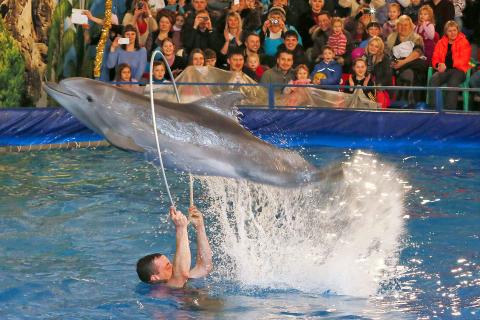France on May 6 banned the breeding in captivity of dolphins and killer whales under tighter rules that campaigners hope will eventually herald the end of shows involving the animals.
Environment Minister Segolene Royal had on May 3 signed a version of the legislation introducing “tight controls on the reproduction of dolphins,” her ministry said in a statement. But she has since decided the rules need to be “more radical,” her ministry told AFP on May 6, particularly after learning that “some animals were drugged” in aquariums.
The new rules ban the captivity of all whales, dolphins and porpoises, except for orcas and bottlenose dolphins already held in authorized aquariums.

Photo: Reuters
照片:路透社
Animal rights activists hailed the ban as a “historic French advance.” “In plain terms, this means the end of breeding, exchange and import programs,” five conservation groups including One Voice and Sea Shepherd said in a joint statement. “Without possible replenishment, this quite simply means the scheduled end of marine circuses on our territory.”
The new rules notably also require “an increase of at least 150 percent of pools to allow the animals to live in less proximity from visitors and other animals,” the ministry said, as well as banning chlorine in treating the water. Direct contact between the animals and the public is also now forbidden. Water parks and aquariums have six months to conform to the new rules, and a three-year deadline for expanding their pools.
(AFP)
法國於五月六日立法嚴格禁止國內以人工方式繁殖海豚和殺人鯨。動物保育人士期望新法能夠終結海豚表演。
根據法國環境部所發表的聲明,部長塞格琳‧賀雅爾五月三日簽署了一項法案,嚴格限制海豚的人工繁殖,但她在五月六日告訴法新社,她隨後得知有水族館對動物下藥,因此決定制定更嚴厲的法令。
新法禁止豢養任何品種的鯨魚、海豚、鼠海豚,只有部分已經飼有殺人鯨和瓶鼻海豚,且經政府核准的水族館可以繼續豢養海豚。
動物權人士稱新法為「法國歷史上的重大進步」。包含「一個聲音」、「海洋守護者協會」在內的五個動保團體發表聯合聲明指出:「簡單來說,這個法令的意義在於終結國內鯨豚的人工繁殖、交易和進口」,因為「只要鯨豚的供應無法持續,國內的鯨豚表演就必然會有結束的一天。」
值得注意的是,新法也規定水族館必須將鯨豚的水池增大至少一點五倍,以拓寬鯨豚和遊客及其他動物之間的距離。此外,新法也禁止水族館在水中加入氯,並禁止鯨豚和一般大眾直接接觸。海洋公園和水族館須於三年內擴建水池,並於六個月內改善其他新法所提及之事項。
(台北時報編譯涂宇安譯自法新社)

★ Bilingual Story is a fictionalized account. 雙語故事部分內容純屬虛構。 “Any New Year’s resolutions?” he asked. Lena put her coffee down. “Yeah,” she said. “To get in shape.... round is a shape, right?” Mark chuckled. “I support this. Fully achievable. Low risk.” “Thanks,” she smiled and lovingly rubbed her round belly. “I like a resolution I can’t fail.” “Funny thing is, I was thinking about getting round too.” Lena nodded her head in approval, “You could put some meat on those skinny bones of yours.” Mark shook his head, “Not that kind of round. Wheel-of-Life round.” She raised an eyebrow.

Skating is a popular recreational and competitive activity that involves sliding over surfaces using specially designed footwear. Its origins date back over 1,000 years to Northern Europe, where people first strapped animal bones to their feet to move across frozen lakes and rivers. In the 17th century, the Dutch transformed skating into a leisure activity. They also replaced bone blades with metal, leading to the creation of modern ice skates. Today, ice skating is enjoyed as a global sport and an exciting pastime by people of all ages. Figure skating is one of the best-known and most graceful forms of skating.

對話 Dialogue 清清:最近天氣越來越冷,感覺很容易感冒,要不要一起去吃薑母鴨或是羊肉爐? Qīngqing: Zuìjìn tiānqì yuèláiyuè lěng, gǎnjué hěn róngyì gǎnmào, yào bú yào yìqǐ qù chī jiāngmǔyā huòshì yángròulú? 華華:最近我覺得有點累,想吃薑母鴨,可是又怕一下子吃太補會上火。 Huáhua: Zuìjìn wǒ juéde yǒudiǎn lèi, xiǎng chī jiāngmǔyā, kěshì yòu pà yíxiàzi chī tài bǔ huì shànghuǒ. 清清:那我們去喝香菇雞湯吧,不太容易上火,喝了也會很暖和。 Qīngqing: Nà wǒmen qù hē xiānggū jītāng ba, bú tài róngyì shànghuǒ, hē le yě huì hěn nuǎnhuo. 華華:聽起來不錯!你們家平常冬天都吃什麼進補? Huáhua: Tīng qǐlái búcuò! Nǐmen jiā píngcháng dōngtiān dōu chī shénme jìnbǔ? 清清:我家都煮麻油雞,吃完整個人手腳都會熱起來。我也很久沒喝香菇雞湯了,正好可以去打打牙祭。 Qīngqing: Wǒ jiā dōu zhǔ máyóujī, chī wán zhěnggè rén shǒujiǎo dōu huì rè qǐlái. Wǒ yě hěn jiǔ méi hē xiānggū jītāng le, zhènghǎo kěyǐ qù dǎ dǎ yájì. 華華:可是我最近在減肥,會不會吃得太補,肉又長回來了? Huáhua: Kěshì wǒ zuìjìn zài jiǎnféi, huì bú

A: South Korea’s Golden Disc Awards ceremony is taking place at the Taipei Dome on Saturday. Eighteen acts are taking to the stage, including Blackpink’s Jennie. B: The hottest boy group CORTIS is also performing. I can’t wait to see James, the Taiwanese member of the band, perform. A: Who else are playing at the K-pop show? B: This year’s lineup is stacked, including: Allday Project, ARrC, Ateez, Boynextdoor, Close Your Eyes, Enhypen, IVE, Izna, KiiiKiii, Le Sserafim, Monsta X, NCT Wish, Stray Kids, TWS, Zerobaseone and Zozazz. A: SKZ, Enhypen and Ateez dominated Billboard’s 2025 Year-End World